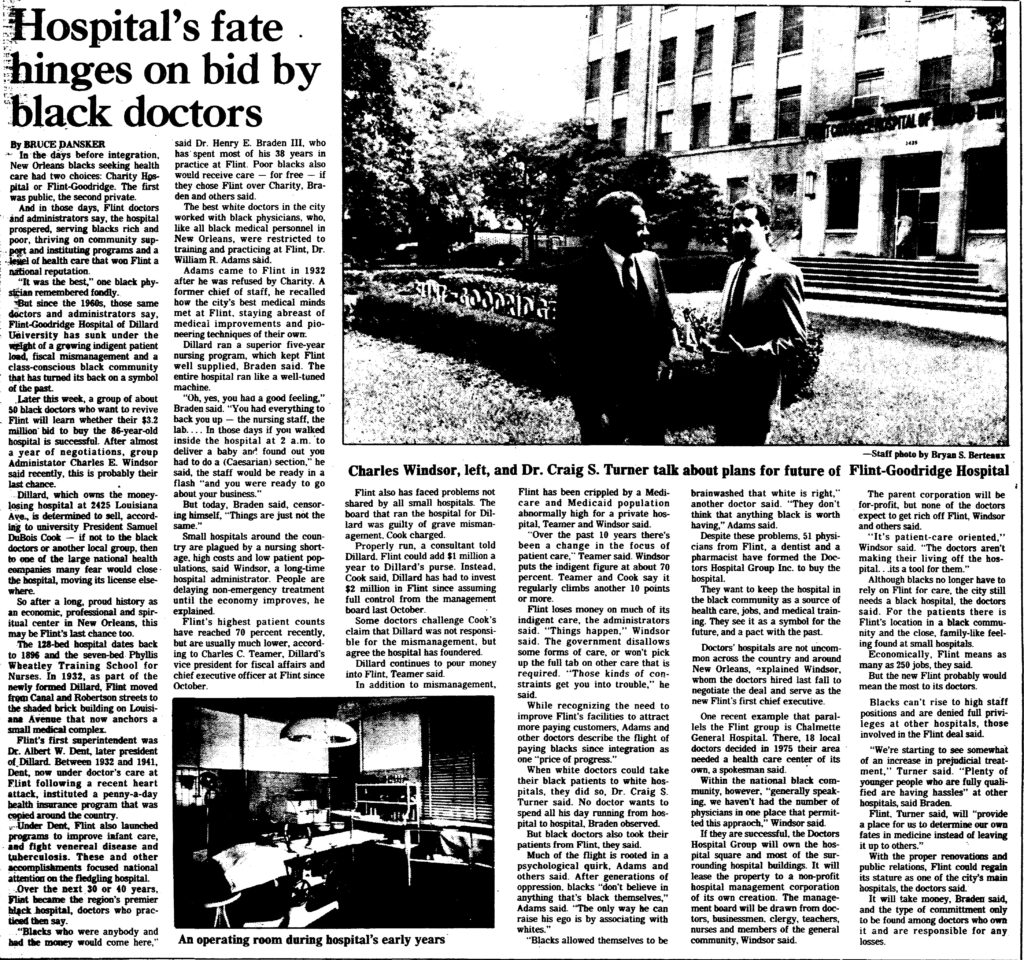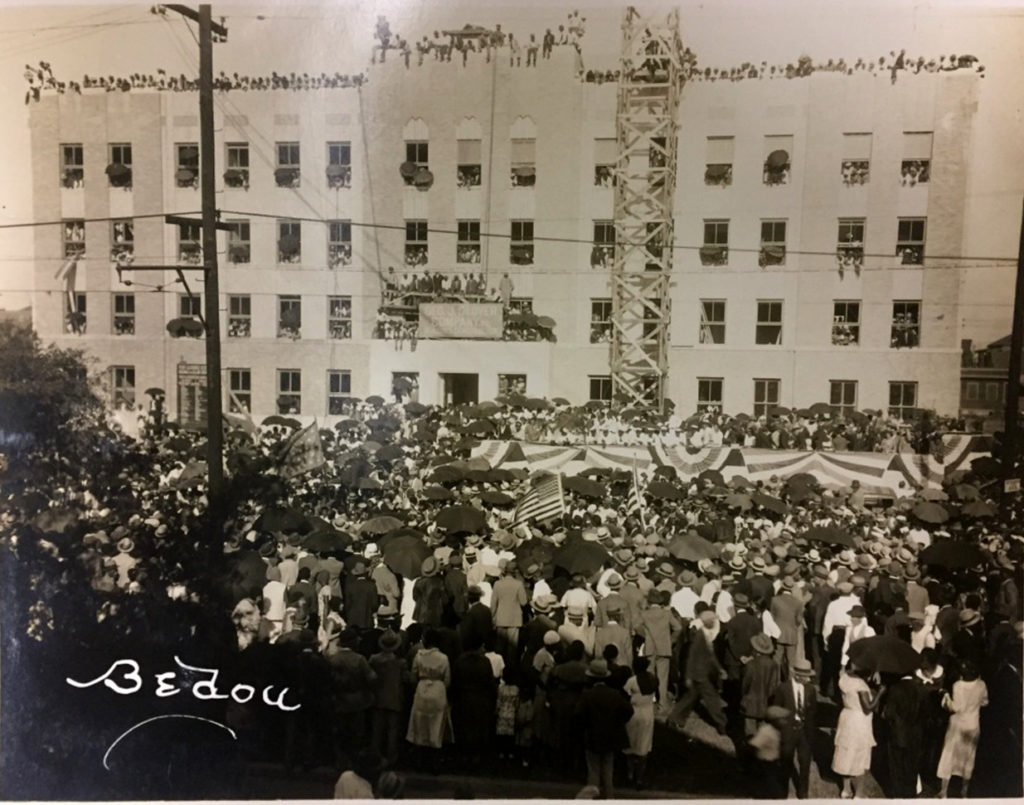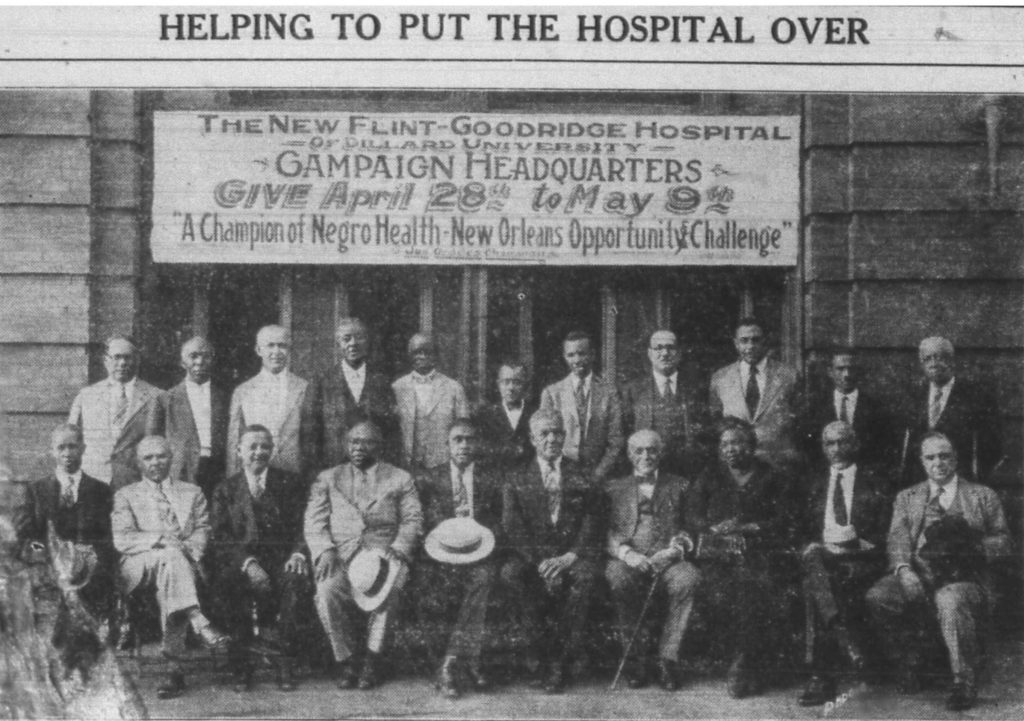This year marks the fortieth anniversary of the attempt in 1982 by fifty-one African American physicians, dentists, and pharmacists to save the historic Flint-Goodridge Hospital from its eventual closure in 1983. For nearly a century, beginning in 1896, Flint-Goodridge (which was attached to Dillard University) served the city’s Black community and provided Black physicians, nurses, and medical technicians with a teaching hospital and a setting in which they would be fully respected as medical professionals. Prior to the 1960s, it was virtually impossible for African American physicians to secure residencies or admitting privileges in mainstream hospitals. Even in locales where they did have hospital privileges, they were subjected to all number of personal and professional slights. Likewise, African American nurses had limited options for gaining experience outside of Black teaching hospitals. A more complete historical sketch of the Flint-Goodridge was published on CreoleGen in 2012.

“Hospital’s Fate Hinges on Bid by Black Doctors,” The Times-Picayune, 4 July 1982.
Aware of Flint’s significance, in December 1981, fifty-one physicians, dentists, and pharmacists formed the Doctors’ Hospital Group, Inc. (DHG) to explore the possibility of a physician-owned hospital, a concept that had met with success in numerous other cities. The group was led by Dr. Dwight McKenna (President); Dr. Charles H. D. Bowers, Jr. (Vice-President); and Dr. Joseph M. Epps (Secretary). They hired veteran medical executive, Charles E. Windsor, as DHG’s administrator. They were aided in their attempts at raising capital by New Orleans-native and investment banker Keith Butler. Flint-Goodridge, like many businesses and institutions that developed during the Jim Crow era, was a victim of the psychological shift after integration. Dr. Willie Roosevelt Adams, who was the hospital’s longtime Chief of Staff, described it bluntly: “Blacks allowed themselves to be brainwashed that white is right. They don’t think that anything black is worth having.” Though the group reached a final bid offer of $3.2 million dollars, although some terms of the bid were unacceptable to Dillard University. Ultimately, the hospital was sold in March 1983 to Westbank Medical Center, a subsidiary of National Medical Enterprises for $1.8 million dollars. DHG President Dwight McKenna expressed the sense of loss and predicted a bleak future for the institution: “I just don’t think this hospital should have been sold outside the black community … [The sale is] a setback to the black medical community we may never overcome. By May 1985, National Medical Enterprises had closed the hospital and later donated the site to the City of New Orleans.

Dedication of Flint-Goodridge Hospital, 1 February 1932, Arthur P. Bedou, photographer; Flint-Goodridge Hospital Collection, University Archives, Will W. Alexander Library, Dillard University.
The efforts of the broad coalition of medical providers to save Flint in the 1980s were reminiscent of the group of community leaders who gathered to raise funds for the construction of the new (and existing) Flint-Goodridge Hospital building in 1930. With outside contributions from the Rockefeller Foundation, Rosenwald foundation, and the Methodist and Congregationalist churches, combined with local fundraising, this group was successful in dedicating the new Art Deco campus in February 1932. Pictured below are the members of the fundraising committee for the new hospital campus. They were led in their efforts by undertaker and Tuskegee alumnus, Joseph P. Geddes, who served as Chairman of the campaign. The Vice-Chairman was undertaker and civic leader, Arnold L. Moss.

Fundraising Campaign Committee, 1930
Standing, left to right: Ruby J. Vining, M.D.; Dean Robert B. Hayes of New Orleans University; Percy P. Creuzot, M.D.; James E. Gayle, bookseller and NAACP leader; Smith W. Green, Supreme Chancellor, Knights of Pythias; George Arthur, representative of the Julius Rosenwald Foundation; Edward B. Spriggins, journalist; William H. Mitchell, Jr., YMCA Executive Secretary; Dr. Matthew S. Davage, President of Clark College; Professor Lawrence D. Crocker, school principal; William E. Weeks, M.D.
Seated, left to right: Leonidas T. Burbridge, M.D.; Emile J. LaBranche, Pharm.D.; Emile Labat, undertaker; Aaron W. Brazier, M.D.; Charles H. D. Bowers, M.D., Colonel of the Sales Army; Joseph P. Geddes, undertaker and Chairman of the Campaign; Arnold L. Moss, undertaker and Vice-Chairman of the Campaign; Mrs. Ida Tropez King, businesswoman and District Grand Most Noble Governor, Household of Ruth; Rivers Frederick, M.D.; Bishop Robert E. Jones of the Methodist Episcopal Churches.
Sources: “Physicians Fail in Bid to Buy Hospital,” The Advocate (Baton Rouge), 10 July 1982, p. 4B; “Hospital’s Fate Hinges on Bid by Black Doctors,” The Times-Picayune (New Orleans), 4 July 1982, sec. 1, p. 14; “Prognosis for Hospital Improves,” The Times-Picayune, 28 August 1983, sec. 1, p. 9; “Flint Goodridge Hospital Site is Offered to City as Donation,” The Times-Picayune, 19 March 1986, p. A24.
Jari C. Honora



Wonderful article … as usual, Jari!
#Joseph P Geddes was my great-great uncle.
I was born at #Flint Goodridge Hospital.
Great story. Thanks for the history lesson.
I was born and raised in New Orleans. I remember Flint-Goodridge. My father received all of his medical procedures at Flint. My older brother was born at Flint. Thank you for this piece of history.
Its a shame how some of our elders thought that white was right.